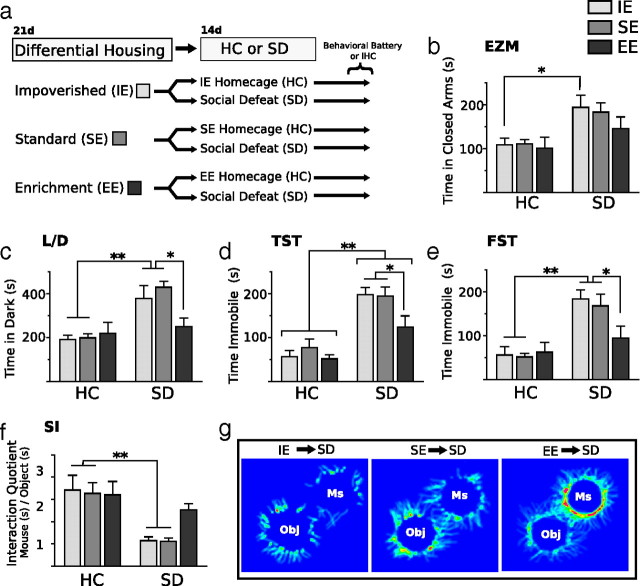Figure 1.
Previous exposure to environmental enrichment insulates mice from the deleterious effects of social defeat stress. a, Diagram depicting experimental groups and study design. Initial cohorts of mice were housed in EE, SE, or IE conditions for 3 weeks. After differential housing, mice either remained in their respective HC environment or were transferred to SD conditions for 2 weeks. After SD or HC exposure, mice either underwent a behavioral test battery or brains were processed for FosB/ΔFosB immunostaining. b–g, The anxiogenic and depressogenic qualities of SD stress were tested in the elevated zero maze (EZM, b), light/dark box (L/D, c), tail-suspension test (TST, d), forced-swim test (FST, e), and social interaction task (SI, f, g). Mice housed in IE or SE before SD showed increased anxiety- and depressive-like behaviors after SD. SE→SD and IE→SD mice spent more time in the dark compartment compared with all other groups (c) and showed increased immobility in the tail-suspension test and forced-swim test (d, e) compared with EE→SD mice and HC control groups. In the social interaction task, mice were allowed to explore an open field containing two wire cups, one empty and one containing the aggressor CD-1 male mouse from the SD living conditions. Compared with SE→SD and IE→SD mice, EE→SD mice spent significantly more time and showed a significant increase in preference for interacting with the aggressor mouse (f, g). Ms, Mouse; Obj, object. Results are expressed as mean ± SEM (n = 8 per group). For b–f, two-way ANOVA was followed by Bonferroni's post hoc test. Bonferroni's test: *p < 0.05; **p < 0.01.

